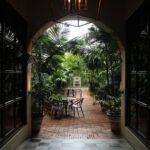Ideas for modern gardens have evolved over the years, with a focus on embracing simplicity, sustainability, and innovative design elements. Modern garden design goes beyond traditional concepts and incorporates ideas that reflect contemporary lifestyles and aesthetics. From minimalist layouts to the use of eco-friendly materials and smart technology, modern gardens offer endless possibilities for creating outdoor spaces that are both stylish and functional.
The concept of modern garden design is all about reimagining outdoor spaces in a way that complements today’s architectural styles and urban living. This approach embraces clean lines, open spaces, and a seamless integration of nature with modern elements. By exploring new ideas for modern gardens, homeowners can transform their outdoor spaces into tranquil retreats and extensions of their indoor living areas.
In this article, we will delve into various aspects of modern garden design, including minimalist layouts, sustainable elements, outdoor living spaces, plant selection, landscape architecture, creative use of materials, smart technology, and personalization tips. Whether you’re looking to overhaul your existing garden or create a brand-new outdoor oasis from scratch, these ideas will inspire you to elevate your outdoor space to suit the demands of modern living.
Minimalist Garden Design
Simple Plant Selection
When considering ideas for modern gardens with a minimalist approach, it’s essential to carefully select plants that contribute to the overall clean and simple look. Opt for plants with sleek foliage, such as ornamental grasses, succulents, or architectural plants like agave and yucca. Limit the variety of plant species to create a cohesive and harmonious landscape without overwhelming the visual appeal of the garden.
Clean Lines and Functional Spaces
Incorporating clean lines in hardscaping elements such as pathways, decking, and seating areas is essential in minimalist garden design. Consider using materials like concrete, wood, or metal to create geometric shapes or straight-line patterns. Functional spaces like outdoor seating areas or dining spaces should be strategically placed to maintain an uncluttered look while promoting relaxation and enjoyment of the outdoor environment.
Efficient Irrigation Systems
Utilizing smart irrigation systems is an excellent way to maintain a minimalist garden while conserving water. Drip irrigation or moisture sensors can ensure that plants receive just the right amount of water they need without wasting resources. By incorporating these high-tech features into your modern garden, you can achieve a sustainable and eco-friendly outdoor space that aligns with minimalist design principles.
By embracing simplicity and clean lines in plant selection, hardscaping elements, and utilizing efficient irrigation systems within your modern garden design plans can create a stunning outdoor space that reflects contemporary aesthetics while promoting sustainability.
Incorporating Sustainable and Eco-Friendly Elements
In today’s environmentally conscious world, many homeowners are seeking ways to incorporate sustainable and eco-friendly elements into their gardens. Taking a cue from nature, modern garden design can seamlessly integrate these principles, resulting in beautiful outdoor spaces that promote environmental stewardship. Here are some ideas for creating an environmentally conscious modern garden.
Native Plant Selection
One of the best ways to promote sustainability in your garden is by selecting native plants. These plants are naturally adapted to your local climate and soil conditions, requiring less water, fertilizer, and maintenance. Additionally, native plants support local ecosystems by providing food and habitat for native wildlife, contributing to biodiversity in your garden.
Water-Wise Design
Incorporating water-wise design principles is essential for creating an eco-friendly modern garden. This may include installing a rainwater harvesting system to collect and store rainwater for irrigation, choosing drought-tolerant plants that require minimal watering, and implementing efficient irrigation methods such as drip systems. By reducing water consumption in your garden, you can contribute to water conservation efforts while still maintaining a vibrant outdoor space.
Sustainable Materials
When designing hardscapes or outdoor structures in your modern garden, consider using sustainable materials such as reclaimed wood, recycled composite decking, or locally sourced stone. These eco-friendly options not only reduce the environmental impact of your garden but also add unique character and texture to the overall design. By prioritizing sustainable materials, you can create a modern garden that upholds ethical and ecological values without sacrificing style or functionality.
By integrating these sustainable and eco-friendly elements into your modern garden design, you can create an outdoor space that not only reflects contemporary aesthetics but also promotes environmental responsibility. With thoughtful planning and consideration for nature, you can enjoy a beautiful garden while minimizing your ecological footprint and contributing to a healthier planet.
Outdoor Living Spaces
One of the key elements in modern garden design is the creation of outdoor living spaces that seamlessly blend with indoor areas. This concept allows homeowners to maximize their living space and enjoy a seamless transition from their interior to their exterior. There are several ways to achieve this seamless integration, including the use of furniture, lighting, and landscaping.
To create a seamless transition between indoor and outdoor areas in modern gardens, consider the following ideas:
- Use of sliding or bi-fold doors: Installing large glass doors that can be fully opened to connect the indoor and outdoor spaces.
- Consistent flooring: Using the same or similar flooring materials both indoors and outdoors can help to visually connect the two areas.
- Functional furniture: Choosing furniture pieces that serve dual purposes for indoor and outdoor use, such as weather-resistant sofas and tables.
- Incorporating greenery: Planting trees, shrubs, and other greenery near windows and doorways creates a natural connection between indoor and outdoor spaces.
Additionally, creating designated functional areas such as dining spaces, lounging areas, or outdoor kitchens can further enhance the cohesive flow between indoor and outdoor living spaces. By carefully considering the layout, materials, and furnishings in both areas, homeowners can achieve a modern garden design that seamlessly connects their interior living space with their outdoor retreat.
Overall, creating a seamless transition from indoor to outdoor areas in modern garden design requires thoughtful planning and consideration of how each space complements one another. By incorporating these ideas into your own garden design, you can create a cohesive living environment that enhances your overall quality of life.
Plant Selection and Landscape Architecture
When it comes to modern garden design, the selection of plants and the layout play a crucial role in achieving the desired aesthetic. Embracing clean lines, simplicity, and a sense of spaciousness are key elements of modern gardens. Here are some ideas for selecting plants and designing layouts that complement modern aesthetics:
- Consider using geometric shapes and patterns in your plant selection and layout to create a sense of order and symmetry in your garden.
- Opt for low-maintenance plants with sleek foliage or architectural shapes that contribute to a minimalist look. Grasses, succulents, bamboo, and ornamental grasses are great choices for modern gardens.
- Incorporate a limited color palette to create a cohesive and harmonious look. Choose plants with foliage in shades of green, silver, black, or white to maintain a contemporary feel.
In addition to plant selection, landscape architecture plays a vital role in creating a modern garden. The arrangement of plants, hardscape features, and outdoor structures should all contribute to the overall aesthetic. Here are some ideas for designing layouts that complement modern aesthetics:
- Create defined pathways using materials such as concrete pavers or gravel to add structure and visual interest to your garden.
- Integrate different levels within your garden by incorporating raised beds, terraces, or retaining walls to add depth and dimension to the space.
- Experiment with asymmetrical designs or linear formations to create visual impact while maintaining a contemporary look. Balance is key when designing the layout of a modern garden.
By carefully selecting plants and thoughtfully designing layouts that embrace modern aesthetics, you can create a beautiful and stylish outdoor space that reflects your personal style while staying true to the principles of contemporary garden design. Remember that there are no strict rules when it comes to creating a modern garden – allowing you the freedom to express individuality within established guidelines is part of what makes this exercise so rewarding.
Creative Use of Materials
In recent years, modern garden design has been increasingly popular as more homeowners seek to update their outdoor spaces with contemporary aesthetics. One key aspect of modern garden design is the creative use of materials, which allows for innovative and bold landscaping choices. Incorporating materials such as concrete, steel, and modern composites can add visual interest and a sense of sophistication to a garden while simplifying maintenance.
Concrete is a versatile material that can be used in various ways in modern garden design. From creating sleek, minimalist pathways to crafting geometric planters and seating areas, concrete lends a clean and polished look to the outdoor space. Additionally, steel is another material that adds a touch of industrial charm to modern gardens. From using steel for edging and fencing to incorporating steel sculptures or water features, this material can make a striking statement in the garden.
Furthermore, other modern materials such as corten steel or composite decking can also be explored for unique and contemporary garden designs. Incorporating these materials into the landscape architecture can create an aesthetically pleasing contrast with natural elements like plants and water features. Ultimately, embracing the creative use of materials in modern garden design provides an opportunity for homeowners to personalize their outdoor spaces and create truly unique environments.
| Modern Material | Potential Use |
|---|---|
| Concrete | Pathways, planters, seating areas |
| Steel | Edging, fencing, sculptures, water features |
| Corten Steel/Composite Decking | Landscape architecture contrast with natural elements |
Smart Garden Technology
In today’s fast-paced world, technology has become an integral part of our lives, and it has also made its way into modern garden design. Smart garden technology offers innovative solutions to make gardening more convenient and efficient while also contributing to sustainable practices. One of the key elements of smart garden technology is the use of smart irrigation systems.
These systems are designed to deliver the right amount of water to plants, adjusting to factors such as weather conditions and soil moisture levels. By using smart irrigation systems, modern gardens can conserve water and promote healthier plant growth.
Another aspect of smart garden technology is the integration of high-tech lighting features. LED lighting not only adds a modern touch to outdoor spaces but also offers energy-efficient options for illuminating gardens during the evening hours. Additionally, programmable lighting systems can be used to create ambience and enhance the overall aesthetic of a modern garden.
Furthermore, high-tech features such as automated lawn mowers, weather sensors, and even robotic planters are becoming increasingly popular in modern garden design. These technological advancements not only streamline maintenance tasks but also allow gardeners to have more time to enjoy their outdoor living spaces. As technology continues to evolve, there are endless possibilities for incorporating smart garden technology into modern gardens, allowing for greater efficiency and sustainability in garden design.
The integration of these high-tech features into modern gardens reflects the growing desire for convenience and sustainability among contemporary homeowners. By embracing smart garden technology, individuals can create outdoor spaces that not only look stylish but also function efficiently and promote eco-friendly practices.
As we continue to advance in the digital age, it is important for modern garden designs to evolve alongside these technological innovations to create truly remarkable outdoor environments that cater to both aesthetic desires and practical needs.
Personalizing Your Modern Garden
When it comes to modern garden design, adding personalized touches can truly make your outdoor space stand out. One idea for personalizing your modern garden is to incorporate art pieces or sculptures that reflect your personality and style. This could be anything from abstract metal sculptures to intricately designed pottery. These unique touches can serve as focal points in the garden and add an artistic flair to the overall design.
Another way to personalize your modern garden is to create a designated relaxation area that suits your lifestyle. This could be a cozy reading nook with a comfortable chair and ample shade, or a small meditation area surrounded by lush greenery. By tailoring this space to your needs and preferences, you can ensure that your garden becomes not only aesthetically pleasing but also functional for day-to-day use.
In addition, considering the incorporation of personal hobbies into the garden design can be an interesting approach. For instance, if you have a passion for cooking, you could include an outdoor kitchen or herb garden. If you are an avid bird watcher, you might want to attract local bird species by adding feeders or birdbaths. By integrating elements that resonate with your interests, you can create a modern garden that feels uniquely yours.
| Ideas for Personalizing Your Modern Garden | Example |
|---|---|
| Incorporate art pieces or sculptures | Abstract metal sculptures or intricately designed pottery |
| Create a designated relaxation area | Cozy reading nook or small meditation area |
| Incorporate personal hobbies into the garden design | Outdoor kitchen, herb garden, bird feeders/birdbaths |
Conclusion
In conclusion, modern garden design offers a range of exciting possibilities for creating unique and stylish outdoor spaces. From embracing minimalist principles to incorporating eco-friendly elements and utilizing smart technology, there are numerous ways to achieve a contemporary and sustainable garden that reflects your personal style. Furthermore, the creative use of materials and thoughtful plant selection can play a crucial role in complementing the overall modern aesthetic of your garden.
As the concept of modern garden design continues to evolve, it is essential to consider not only the visual appeal but also the functionality and sustainability of your outdoor space. By incorporating outdoor living spaces and personalized touches, you can create a seamless transition from indoor to outdoor areas, making your garden an inviting extension of your home.
Now is the time to start implementing your own ideas for modern gardens. Whether you are looking to create a tranquil retreat or an entertainment hub in your backyard, there are endless opportunities to explore and experiment with modern garden design. By integrating the key elements discussed in this article and infusing them with your creativity, you can develop a modern garden that truly resonates with your lifestyle and enhances your outdoor living experience.
Frequently Asked Questions
What Is Modern Garden Style?
Modern garden style typically includes clean lines, minimalistic design, and a focus on functionality. It often incorporates elements like concrete, metal, and geometric shapes to create a contemporary look that is low-maintenance and visually striking.
How Do You Modernise a Traditional Garden?
To modernize a traditional garden, you can start by decluttering the space and removing any outdated or overly ornate features. Introducing sleek, contemporary furniture, adding architectural plants, and incorporating modern landscaping materials can also help achieve a more updated aesthetic.
How Do You Make a Unique Garden?
Creating a unique garden involves thinking outside the box and infusing your personal style into the space. This could mean incorporating unconventional plant choices, implementing creative pathways or structures, or even adding artistic elements such as sculptures or mosaic designs. The key is to showcase your individuality through innovative gardening choices.

Welcome to my gardening blog! I am passionate about plants and enjoy sharing my knowledge and experiences with others. In this blog, I will write about everything related to gardening, from tips on how to get started to updates on my own garden projects.





